Phylloporus Quél.
The only European member of this genus is instantly recognized due to the peculiar structure of its gilled hymenophore (see the illustrations below). Molecular studies show that P. pelletieri is closely related to the xerocomoid boletes around Xerocomus subtomentosus. For purely practical purposes it is here retained in a genus on its own.
Phylloporus pelletieri (Lév.) Quél.
Description
Cap up to 8 cm, at first hemispherical then expanding to convex or flat, brick-coloured, brown to reddish brown, at first velvety, then glabrous. Stipe cylindrical and usually tapering towards the base, yellowish, in various degree covered with very fine reddish to reddish brown granules. Flesh yellow or yellowish, under the cuticle pinkish to brownish red, unchanging when exposed to air. Gills thick, waxy, interconnected with transverse connections, bright yellow. Smell not distinctive. Taste agreeable. Spores 10–14.5 × 4–5 μm.
Habitat. Coniferous, mixed and deciduous forests, mycorrhizal with presumably both conifers and broadleaf trees.
Distribution. Widespread throughout Europe, but more or less rare.
Photographs
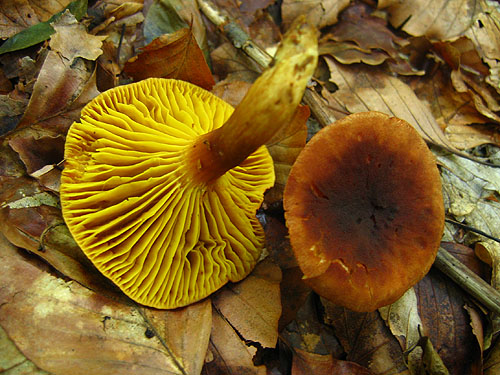
Fruitbodies of Phylloporus pelletieri. (photo B. Assyov)
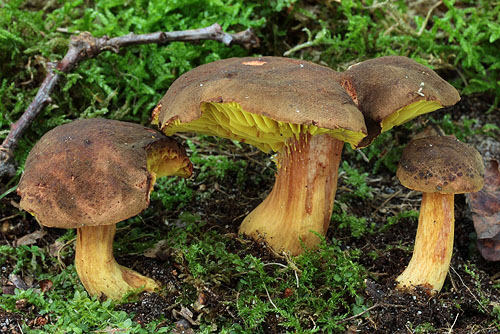
Fruitbodies of Phylloporus pelletieri. Note the surface of the cap reminding a species of Xerocomus. (photo M. Mikšík)
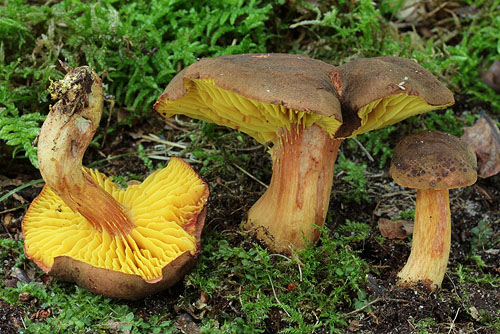
Fruitbodies of Phylloporus pelletieri. The yellow colour of the hymenophore is very characteristic. (photo M. Mikšík)
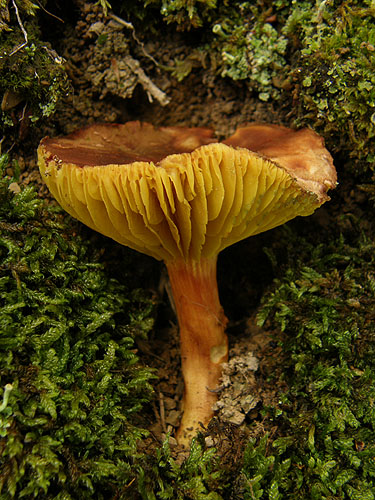
Typical fruitbody of Phylloporus pelletieri. (photo B. Assyov)
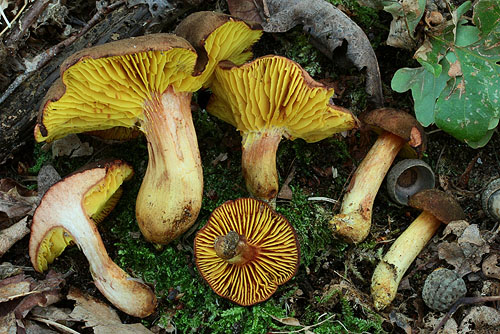
Fruitbodies of Phylloporus pelletieri. Note the colour of the flesh. (photo M. Mikšík)

Detail of the gills of Phylloporus pelletieri. Note the transverse connections. (photo B. Assyov)
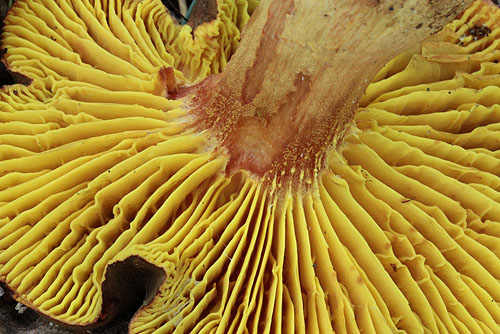
One more aspect of the gills of Phylloporus pelletieri. (photo M. Mikšík)

The first known illustration of Phylloporus pelletieri. It was published in Kalchbrenner & Schulzer's Icones Selectae Hymenomycetum Hungariae and accompanyies the original description of Agaricus paradoxus, a synonym of P. pelletieri.
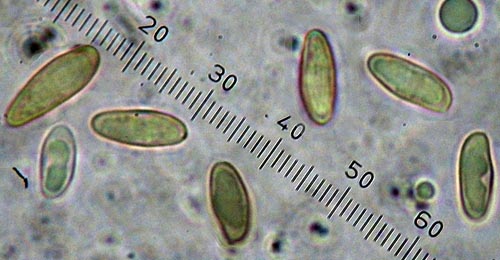
Spores of Phylloporus pelletieri. (photo G. Konstantinidis)
Important literature
Alessio, C.L. 1985. Boletus Dill. ex L. (sensu lato). – In: Fungi Europaei. Vol. 2. Pp. 1–705. Libreria editrice Biella Giovanna, Saronno.
Breitenbach J. & Kränzlin F. 1991. Pilze der Schweiz. Bd. 3(1). Röhrlinge und Blätterpilze. Verlag Mykologia, Luzern.
Estadès, A. & Lannoy, G. 2004. Les bolets européens. – Bulletin Mycologique et Botanique Dauphiné-Savoie 44(3): 3–79.
Engel, H., Dermek, A., Klofac, W., Ludwig, E. & Brückner, T. 1996. Schmier – und Filzröhrlinge s. l. in Europa. Die Gattungen Boletellus, Boletinus, Phylloporus, Suillus, Xerocomus. Verlag Heinz Engel, Weidhausen b. Coburg.
Hansen, L. & Knudsen, H. 1992. Nordic Macromycetes. Vol. 2. Polyporales, Boletales, Agaricales, Russulales. Nordsvamp, Copenhagen.
Knudsen, H. & Vesterholt, J. [eds.]. 2008. Funga Nordica. Nordsvamp, Kopenhagen.
Ladurner, H. & Simonini, G. 2003. Xerocomus s.l. – In: Fungi Europaei. Vol. 8. Pp. 1–527. Edizioni Candusso, Alassio.
Lannoy, G. & Estadès, A. 2001. Les Bolets. Flore mycologique d’Europe. Documents Mycologiques Mémoire Hors série no. 6. Pp. 1–163. Association d’Écologie et de Mycologie, Lille.
Pilát, A. & Dermek, A. 1974. Hríbovité huby. Československé hríbovité a sliziakovité huby (Boletaceae – Gomphidiaceae). Veda, Bratislava.
Šutara, J., Mikšík, M. & Janda, V. 2009. Hřibovité houby. Čeled’ Boletaceae a rody Gyrodon, Gyroporus, Boletinus a Suillus. Academia, Praha.
Watling, R. 1970. Boletaceae, Gomphidiaceae, Paxillaceae. – In: Henderson, D.M., Orton, P.D. & Watling, R. [eds]. British fungus flora. Agarics and Boleti. Vol. 1. Royal Botanic Garden, Edinburgh.
Watling, R. & Hills, A.E. 2005. Boletes and their allies (revised and enlarged edition). – In: Henderson, D.M., Orton, P.D. & Watling, R. [eds]. British Fungus Flora. Agarics and boleti. Vol. 1. Royal Botanic Garden, Edinburgh.